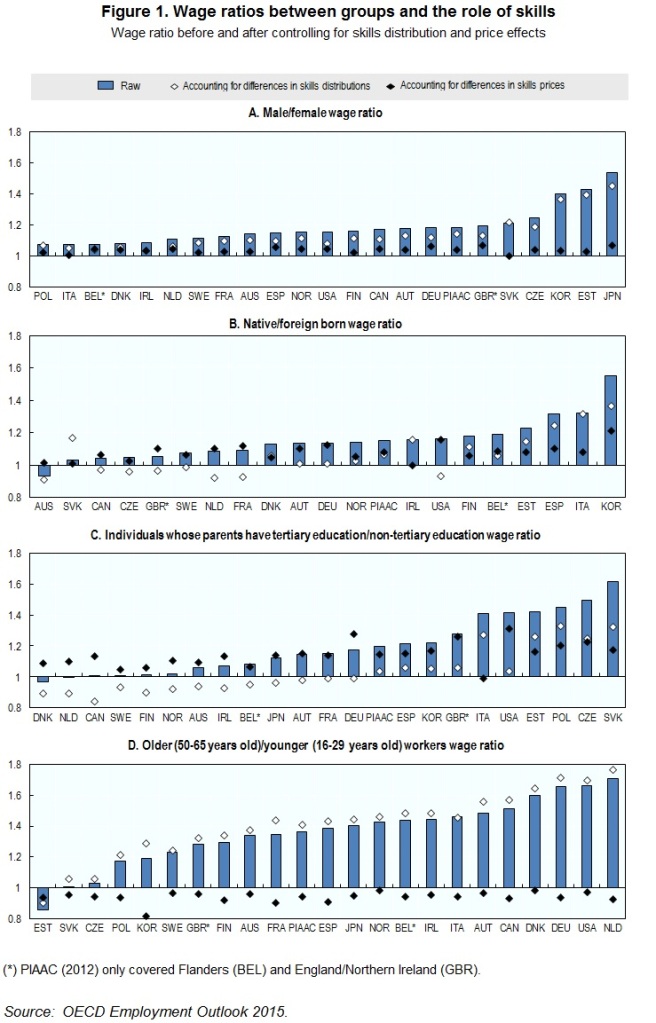The role of cognitive skills in explaining wage differentials between socio-economic groups
[ad_1]
By Marieke Vandeweyer.
Average wages can vary markedly between socio-economic groups. A well-known example is the difference in wages between male and female workers, the so-called gender wage gap. Other examples include the difference in wages between: native- and foreign-born workers; workers with different socio-economic backgrounds – for example those with high-skilled and low-skilled parents; workers of different ethnicities; and older and younger workers. These differences between groups of workers contribute to high overall wage inequality.
Chapter 2 of the Employment Outlook 2015 sheds some light on the contribution of cognitive skills in explaining these wage gaps between socio-economic groups. When skill levels differ strongly between groups we would expect to see larger wage gaps, as returns to skills are generally positive. On the other hand, skills can be rewarded differently in different socio-economic groups (i.e. skills “prices” vary), such that individuals with the same skill level can have significantly different wages. These differences in skill prices can reflect wage discrimination, but also unmeasured factors that have an impact on wages (e.g. innate ability).
Using data from the OECD’s Survey of Adult Skills (PIAAC), it is possible to see how much of the wage difference between socio-economic groups can be explained by different skills distributions, and how much by different skills prices.
Figure 1 shows the (raw) wage ratios for men versus women, native- versus foreign-born workers, workers whose parents are tertiary educated versus workers whose parents have no more than lower secondary education, and older (50 to 55 years old) versus younger workers (16 to 29 years old). On average across the 22 OECD countries participating in PIAAC, men’s wages are 18.4% higher than women’s; those of native-born workers are 15.1% higher than those of foreign-born workers; workers whose parents have tertiary education earn 19.7% more than those whose parents have lower secondary or less; and older workers have wages 36.1% higher than younger workers.
A first point to take away from this figure is that the gaps between socio-economic groups differ significantly across countries. The differences are especially strong for parental education: in Slovakia (the country with the biggest gap) workers with tertiary educated parents earn 62% more than workers with low-educated parents, while in Denmark workers with low-educated parents earn slightly more than workers with high-educated parents.
Figure 1 also shows what would happen to these wage gaps if both groups had the same distribution of skills or if skills were rewarded equally. Skills are measured using numeracy scores from the PIAAC survey. By comparing the counterfactual wage ratios to the actual wage ratio, one gets an idea of how the skills distribution and skill prices contribute to these socio-economic wage differences. Panel A shows that the gender wage gap would not change much if the skill levels of men and women were the same. However, the wage difference would almost totally disappear if the skills of men and women were rewarded at the same rate.
Similarly, numeracy skills appear to play no role in explaining the wage gap between older and younger workers (Panel D). In fact, the wage gap would be even higher if younger workers were given the skills of older workers. On the other hand, if skills were rewarded equally for both groups, young workers would have higher average wages than the older workers. This price effect is likely to pick up differences in skills that are related to experience, and that are not reflected in numeracy scores.
Skills appear to be more important for explaining the wage gap between foreign- and native-born workers, although there are big cross-country differences (Panel B). While equalising the skill distribution of both groups would have no effect on the wage gap in Italy or Ireland, it would result in higher wages for foreign-born than for native-born workers in countries like the United States, France and the Netherlands. Although this may overstate the importance of numeracy skills and hide differences in other competences not measured in PIAAC, the large contribution of skills to the wage gap suggests that inequality between groups can be lowered at least partly by investing more heavily in the skills of foreign-born individuals.
Finally, in all countries, skills are an important driver of wage differences between workers with different parental education (Panel C). In most countries, the wage gap between workers with tertiary educated parents and workers whose parents have at most lower secondary education would (almost) completely disappear (or even reverse) if individuals in both groups had the same skills distribution. This suggests that mobility in education across generations might be relatively low.
In a recent NBER working paper, Glenda Quintini, Stijn Broecke and I extend this analysis by also looking at the racial wage gap (for which data are only available for the United States). The average wage ratio of white versus black or Hispanic ethnic groups equals 1.43, and this ratio would fall by 56% if skills were distributed similarly. Therefore, skills policies targeting the black and Hispanic workers could potentially lead to lower wage inequality in the United States.
Overall, these results suggest that there can be an important role for skills policies in addressing socio-economic wage gaps in OECD countries. This is consistent with recent evidence that suggests that skills are an important factor in explaining overall wage inequality. Both the reduction of skills inequality and the investment in adequate skill supply to meet skill demand have been found to contribute to lower levels of wage inequality.
[ad_2]



